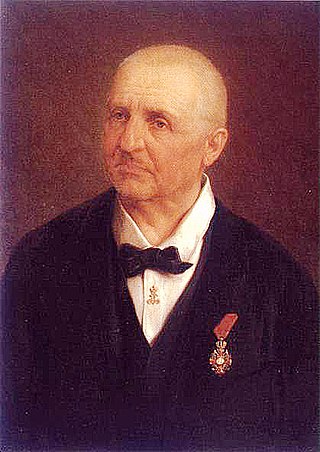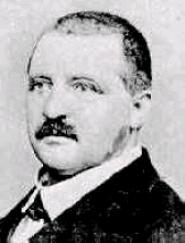
Josef Anton Bruckner was an Austrian composer and organist best known for his symphonies and sacred music, which includes Masses, Te Deum and motets. The symphonies are considered emblematic of the final stage of Austro-German Romanticism because of their rich harmonic language, strongly polyphonic character, and considerable length. Bruckner's compositions helped to define contemporary musical radicalism, owing to their dissonances, unprepared modulations, and roving harmonies.

Anton Bruckner's Symphony No. 5 in B-flat major WAB 105, was written in 1875–1876, with minor changes over the next two years. It came at a time of trouble and disillusion for the composer: a lawsuit, from which he was exonerated, and a reduction in salary. Dedicated to Karl von Stremayr, education minister in the Austro-Hungarian Empire, the symphony has at times been nicknamed the "Tragic", the "Church of Faith" or the "Pizzicato"; Bruckner himself referred to it as the "Fantastic" without applying this or any other name formally.

The Symphony No. 5 in D major/D minor, Op. 107, known as the Reformation, was composed by Felix Mendelssohn in 1830 in honor of the 300th anniversary of the Presentation of the Augsburg Confession. The Confession is a key document of Lutheranism and its Presentation to Emperor Charles V in June 1530 was a momentous event of the Protestant Reformation. This symphony was written for a full orchestra and was Mendelssohn's second extended symphony. It was not published until 1868, 21 years after the composer's death – hence its numbering as '5'. Although the symphony is not very frequently performed, it is better known today than when it was originally published. Mendelssohn's sister, Fanny Mendelssohn Hensel, chose the name Reformation Symphony.

The Symphony No. 6 in A major, WAB 106, by Austrian composer Anton Bruckner (1824–1896) is a work in four movements composed between 24 September 1879, and 3 September 1881 and dedicated to his landlord, Anton van Ölzelt-Newin. Only two movements from it were performed in public in the composer's lifetime. Though it possesses many characteristic features of a Bruckner symphony, it differs the most from the rest of his symphonic repertory. Redlich went so far as to cite the lack of hallmarks of Bruckner's symphonic compositional style in the Sixth Symphony for the somewhat bewildered reaction of supporters and critics alike.

Anton Bruckner's Symphony No. 7 in E major, WAB 107, is one of the composer's best-known symphonies. It was written between 1881 and 1883 and was revised in 1885. It is dedicated to Ludwig II of Bavaria. The premiere, given under Arthur Nikisch and the Gewandhaus Orchestra in the opera house at Leipzig on 30 December 1884, brought Bruckner the greatest success he had known in his life. The symphony is sometimes referred to as the "Lyric", though the appellation is not the composer's own, and is seldom used.

Anton Bruckner's Symphony No. 8 in C minor, WAB 108, is the last symphony the composer completed. It exists in two major versions of 1887 and 1890. It was premiered under conductor Hans Richter in 1892 at the Musikverein, Vienna. It is dedicated to the Emperor Franz Joseph I of Austria.

The Symphony No. 9 in D minor, WAB 109, is the last symphony on which Anton Bruckner worked, leaving the last movement incomplete at the time of his death in 1896; Bruckner dedicated it "to the beloved God". The symphony was premiered under Ferdinand Löwe in Vienna in 1903.

Anton Bruckner's Symphony No. 1 in C minor, WAB 101, was the first symphony the composer thought worthy of performing, and bequeathing to the Austrian National Library. Chronologically it comes after the Study Symphony in F minor and before the "nullified" Symphony in D minor. The composer gave it the nickname Das kecke Beserl, and conducted its 1868 premiere. Much later, after Bruckner was granted an honorary University of Vienna doctorate in 1891, he dedicated the 1890 version of the work to that institution.

Anton Bruckner's Symphony No. 3 in D minor, WAB 103, was dedicated to Richard Wagner and is sometimes known as his "Wagner Symphony". It was written in 1873, revised in 1877 and again in 1889.

Anton Bruckner's Symphony No. 4 in E-flat major, WAB 104, is one of the composer's most popular works. It was written in 1874 and revised several times through 1888. It was dedicated to Prince Konstantin of Hohenlohe-Schillingsfürst. It was premiered in 1881 by Hans Richter in Vienna to great acclaim.

Anton Bruckner's String Quintet in F major, WAB 112 was composed in 1878/79 in Vienna.

The String Quartet in C minor WAB 111, was composed by Anton Bruckner's in 1862 during his tuition by Otto Kitzler.

Christus factus est, WAB 11, is a sacred motet by Anton Bruckner, his third setting of the Latin gradual Christus factus est, composed in 1884. Before, Bruckner composed in 1844 a first piece on the same text as gradual of the Messe für den Gründonnerstag, and in 1873 a motet for eight-part mixed choir, three trombones, and string instruments ad libitum. The motet is an expressive setting of the gradual, influenced by Wagner's music.

Pange lingua, WAB 33, is a sacred motet composed by Anton Bruckner in 1868. It is a setting of the Latin hymn Pange lingua for the celebration of Corpus Christi.

The Symphonisches Präludium in C minor, WAB 332 is an orchestral composition by Anton Bruckner or his entourage, composed in 1876. The work was discovered shortly after World War II. Heinrich Tschuppik, who found the orchestral score of the work in the estate of Bruckner's pupil Rudolf Krzyzanowski, attributed the authorship to Bruckner. Thirty years later, Mahler scholar Paul Banks, who knew only a four-stave reduction of the work, proposed that the work might be attributed to Mahler. While the exact circumstances of the composition of this Prelude have not been determined, it is certain to have been composed within the circle of Bruckner and his students at the Vienna Conservatory of Music. Based on the original orchestral score, it seems likely that the work was at least sketched by Bruckner, possibly as an exercise in orchestration for Krzyzanowski.
The Austrian composer Anton Bruckner composed eleven symphonies, the first, the Symphony in F minor in 1863, the last, the unfinished Ninth symphony from 1893 to 1896.

Gerd Schaller is a German conductor, best known for his performing and recording rare works, including the first full recordings of Bruckner's output.
The Kitzler Study Book is an autograph workbook of Anton Bruckner which he wrote taking tuition with the conductor and cellist Otto Kitzler in Linz. Bruckner tried to complete his knowledge in musical form and instrumentation with Kitzler after the end of his studies with Simon Sechter.











